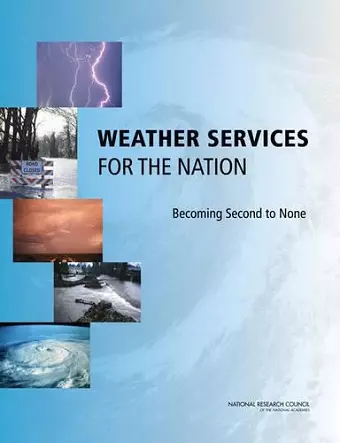Weather Services for the Nation
Becoming Second to None
National Research Council author Division on Earth and Life Studies author Board on Atmospheric Sciences and Climate author Committee on the Assessment of the National Weather Service's Modernization Program author
Format:Paperback
Publisher:National Academies Press
Published:2nd Dec '12
Currently unavailable, and unfortunately no date known when it will be back

During the 1980s and 1990s, the National Weather Service (NWS) undertook a major program called the Modernization and Associated Restructuring (MAR). The MAR was officially completed in 2000. No comprehensive assessment of the execution of the MAR plan, or comparison of the promised benefits of the MAR to its actual impact, had ever been conducted. Therefore, Congress asked the National Academy of Sciences to conduct an end-to-end assessment. That report, The National Weather Service Modernization and Associated Restructuring: A Retrospective Assessment, concluded that the MAR was a success.
Now, twelve years after the official completion of the MAR, the challenges faced by the NWS are no less important than those of the pre-MAR era. The three key challenges are: 1) Keeping Pace with accelerating scientific and technological advancement, 2) Meeting Expanding and Evolving User Needs in an increasingly information centric society, and 3) Partnering with an Increasingly Capable Enterprise that has grown considerably since the time of the MAR.
Weather Services for the Nation presents three main recommendations for responding to these challenges. These recommendations will help the NWS address these challenges, making it more agile and effective. This will put it on a path to becoming second to none at integrating advances in science and technology into its operations and at meeting user needs, leading in some areas and keeping pace in others. It will have the highest quality core capabilities among national weather services. It will have a more agile organizational structure and workforce that allow it to directly or indirectly reach more end-users, save more lives, and help more businesses. And it will have leveraged these capabilities through the broader enterprise. This approach will make possible societal benefits beyond what the NWS budget alone allows.
- Front Matter
- Summary
- 1 The Rationale for Further Evolution of the National Weather Service
- 2 Prioritize Core Capabilities
- 3 Evaluate Function and Structure
- 4 Leverage the Entire Enterprise
- References
- Appendix A: Statement of Task
- Appendix B: Acronyms and Abbreviations
- Appendix C: Biographical Sketches of Committee Members <
ISBN: 9780309259729
Dimensions: unknown
Weight: unknown
86 pages